Interagency Working Group on Ocean and Coastal Mapping Visits MIT Sea Grant
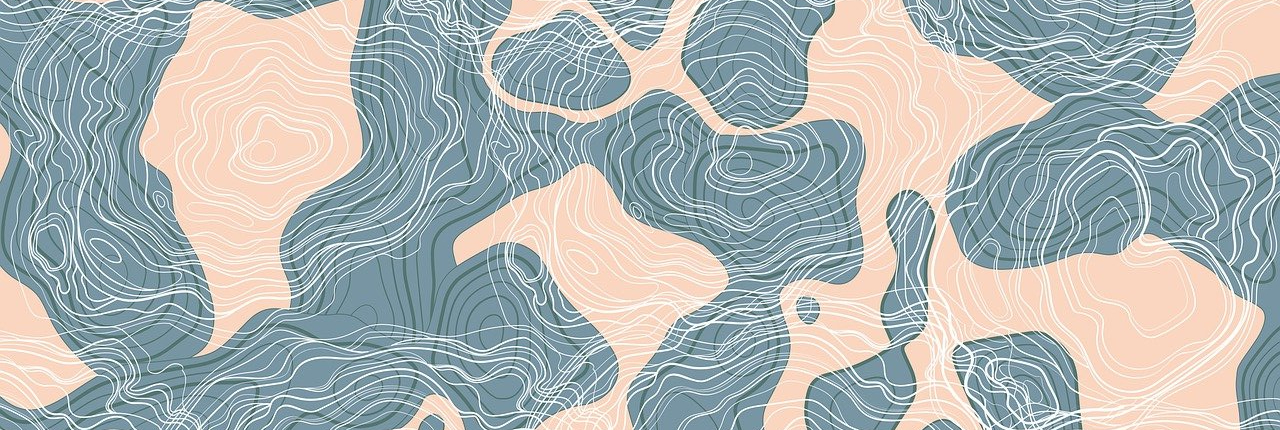
By Avery Plachcinski (Abdul Latif Jameel Water and Food Systems Lab)
On July 11, 2024, the Interagency Working Group on Ocean and Coastal Mapping visited MIT Sea Grant for an overview of the program’s current research, outreach projects, and a tour of the lab facilities. The group was interested in learning more about MIT Sea Grant, the MIT community, and opportunities for collaboration. The Working Group focuses on ocean science and technology and is made up of representatives from several federal agencies, including the Environmental Protection Agency (EPA), the National Oceanic and Atmospheric Administration (NOAA), and the National Science Foundation (NSF). A full list of group members can be found here. Those in attendance represented: NOAA, U.S. Geological Survey, Department of the Interior, U.S. Army Corps, Department of Tribal Relations, and the Office of Coastal Survey. The visit showcased MIT Sea Grant’s efforts to promote the conservation and stewardship of local marine resources through research, education, and service to the local community.
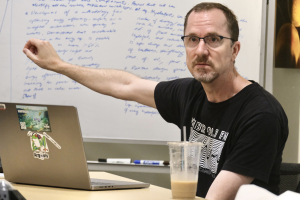
Ben Bray, a geospatial applications developer at MIT Sea Grant, began by highlighting a project funded by MIT’s Abdul Latif Jameel Water and Food Systems Lab (J-WAFS). Led by Professor Michael Triantafyllou, director of MIT Sea Grant, the project focuses on the development of a cloud-based system that optimizes workflows and operations in shellfishing management. Access to shellfish fisheries is regulated in order to manage and maintain their productivity, and managing this can be time consuming and inefficient. Launched with a 2022 J-WAFS Seed Grant, the project aims to increase the productivity of coastal economies by streamlining decision-making with real-time data integration. The web-based system provides a visual representation of overlapping local and state jurisdiction rules to help resource managers determine when an embayment should be opened or closed to shellfishing.
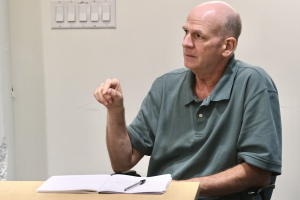 Later, J-WAFS researcher Robert Vincent, PhD, the assistant director of MIT Sea Grant, shed light on another J-WAFS Seed Grant project that aims to reduce the impact that harmful algal bacteria have on hatcheries. Algae is used as feed for shellfish seed production in aquaculture hatcheries and is highly susceptible to harmful bacteria. Vincent is working with Professor Triantafyllou and Otto Cordero, associate professor in the department of Civil and Environmental Engineering, to develop and train a machine learning algorithm that automates the process of counting healthy, unhealthy, and dead shellfish larvae—key information needed to understand the impact of algal bacteria. By automating this, the project makes collecting results more time efficient and accurate. After quantifying the impact of harmful algal bacteria, researchers can determine strategies to improve survival rates in the aquaculture industry.
Later, J-WAFS researcher Robert Vincent, PhD, the assistant director of MIT Sea Grant, shed light on another J-WAFS Seed Grant project that aims to reduce the impact that harmful algal bacteria have on hatcheries. Algae is used as feed for shellfish seed production in aquaculture hatcheries and is highly susceptible to harmful bacteria. Vincent is working with Professor Triantafyllou and Otto Cordero, associate professor in the department of Civil and Environmental Engineering, to develop and train a machine learning algorithm that automates the process of counting healthy, unhealthy, and dead shellfish larvae—key information needed to understand the impact of algal bacteria. By automating this, the project makes collecting results more time efficient and accurate. After quantifying the impact of harmful algal bacteria, researchers can determine strategies to improve survival rates in the aquaculture industry.
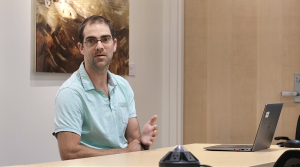 Danny Badger, the marine extension specialist on aquaculture for MIT Sea Grant, presented the program’s efforts to recruit workers to marine industries. MIT Sea Grant’s educational programs expose students to aquaculture, marine ecology, and ocean engineering through K-12 classroom programs, internships, and summer programs. The outreach program specifically targets students who are not typically exposed to marine environments and resources, including those from inland and underserved communities. Badger emphasized the importance of building a diverse workforce that takes part in the development of sustainable marine environments.
Danny Badger, the marine extension specialist on aquaculture for MIT Sea Grant, presented the program’s efforts to recruit workers to marine industries. MIT Sea Grant’s educational programs expose students to aquaculture, marine ecology, and ocean engineering through K-12 classroom programs, internships, and summer programs. The outreach program specifically targets students who are not typically exposed to marine environments and resources, including those from inland and underserved communities. Badger emphasized the importance of building a diverse workforce that takes part in the development of sustainable marine environments.Badger also highlighted the contributions of college students to MIT Sea Grant’s Oystermaran project. The Oystermaran was developed alongside oyster farmers who were struggling to find employees willing to go out in rough tidal conditions to manually flip oyster baskets every ten days.
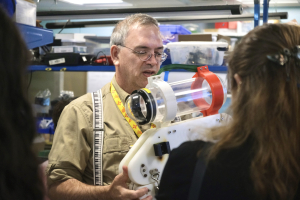
To address this challenge, MIT Sea Grant developed the Oystermaran to automate the arduous task, making the industry more efficient. During the tour, MIT Sea Grant’s education administrator Andrew Bennett, PhD, showcased the latest version of the Oystermaran, which uses cameras to visually track the oyster baskets and battery packs to stay in service for eight hours.
The presentations were informative and engaging, conveying the importance of the program’s research and outreach efforts in addressing the needs of coastal communities. In addition, the visit highlighted the significance of collaboration between industry and academia to achieve solutions and find efficiencies within marine industries.



